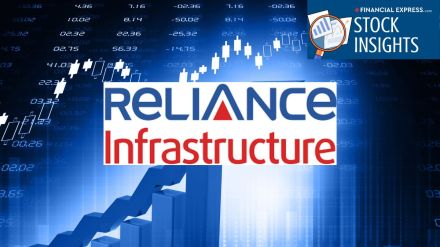Reliance Infrastructure shares have been notably volatile since the last one month. The company has been in the news for many reasons.
The stock is down almost 23% in the last one month. On 8 August, even as the markets fell sharply, the stock of Reliance Infrastructure is up.
Let’s tell you about some reasons for the volatility in the stock.
Before that let’s tell you a little about the company itself…
Reliance Infrastructure Share Price – 1 Month
About Reliance Infrastructure
Reliance Infrastructure is a major Indian private sector company in power generation, infrastructure development, construction, and defence sectors.
The company has diversified interests in power plants, metro rail systems, airports, bridges, toll roads, and defence manufacturing.
Reliance Infrastructure is also a leading utility company with a presence in power distribution.
Why Reliance Infrastructure Shares Are Falling?
The volatility in the price of Reliance Infrastructure due to a few reasons…
#1 Subsidiaries to Recover Rs 214 Billion
Two subsidiaries of Reliance Infrastructure – BSES Yamuna Power and BSES Rajdhani Power – are set to recover about Rs 214.13 bn in regulatory assets over four years.
This recovery follows a Supreme Court ruling which upheld their right to recoup these dues over the next four years, ensuring repayment of unpaid tariffs.
The Delhi Electricity Regulatory Commission (DERC) has already recognised these dues as owed to BSES discoms, which strengthens their recovery prospects significantly.
The company issued a release to the exchanges on 8 August to this effect, which led to a spurt in the stock price, given the huge amount involved.
#2 SEBI’s Investigation into Fund Diversion
There were reports of a SEBI’s investigation into an alleged diversion of Rs 100 bn by Reliance Infrastructure through a series of transactions with another firm.
However, the company issue a clarification which said that it had a net exposure of Rs 65 bn which was duly disclosed in its financial statements since 4 years.
Reliance Infrastructure added in its release to the exchanges that it diligently pursued recovery of its dues in this matter.
Through mandatory mediation proceedings conducted by a retired Supreme Court Judge and the mediation award filed before the Hon’ble Bombay High Court, Reliance Infrastructure arrived at a settlement to recover its 100% exposure of Rs 65 bn.
#3 ED Raids on Anil Ambani Group Companies
The Enforcement Directorate (ED) had conducted extensive raids targeting Anil Ambani-led Reliance Group companies as part of a probe into bank loan fraud and money laundering case.
However, Reliance Infrastructure has clarified that Anil Ambani is not on the Board of Reliance Infrastructure. Accordingly, any action taken against RCOM or RHFL has no bearing or impact on the governance, management, or operations of Reliance Infrastructure.
The company continues to operate in the normal course and the said action has no impact on its business operations.
#4 Quarterly Results
The company’s revenue from operations for Q1 FY26 was Rs 59.07 bn, down about 17.86% year-on-year (YoY). Reliance Infrastructure reported a net profit of Rs 598.4 m for Q1 FY26, a significant turnaround from a loss of Rs 237 m in the same quarter of the previous year (Q1 FY25).
In terms of segments, Mumbai Metro One achieved the highest ever Q1 fare revenue of Rs 840 m.
In the power segment, the transmission & distribution loss for the company reduced below 6.5%, on rolling basis, in Delhi Discoms backed by high operational efficiencies.
All of this contributed to the turnaround in performance.
What Next?
One of the big positives for the company is that it is net debt free.
Also, the company has rapid expansion plans particularly in defence. Reliance Defence partnered with US-based Coastal Mechanics Inc to tap into India’s Rs 200 bn defence maintenance, repair, and overhaul (MRO) market.
Reliance Defence and Coastal Mechanics will focus on providing end-to-end MRO, upgrade, and lifecycle support solutions for the Indian Armed Forces.
It’s targeting a wide range of critical platforms such as 100+ Jaguar fighter aircrafts, 100+ MiG-29 fighter aircrafts, the fleet of Apache attack helicopters, L-70 air defence guns, and other legacy systems that require long-term sustainment and modernisation.
The segment represents a high-value, long-duration opportunity driven by the Indian military’s strategic shift from asset replacement to lifecycle extension and performance-based logistics.
Reliance Defence has signed major partnerships with global defence leaders such as Rheinmetall AG (Germany), Dassault Aviation (France), and the Thales Group for other areas in defence.
On renewable energy side, Reliance Infrastructure is entering solar equipment and battery manufacturing, with plans to establish integrated solar panel and battery production units.
Conclusion
The recovery of Rs 214.13 bn in two subsidiaries is a positive for the company. Also, the foray into defence and solar power space should help the company capture growth opportunities.
It also benefits from rising urbanisation and increased government infrastructure investment.
However, it still faces risks from an economic slowdown, regulatory changes, intensifying competition, and delays in project execution.
To know what’s moving the Indian stock markets today, check out the most recent share market updates here.
Investors should evaluate the company’s fundamentals, corporate governance, and valuations of the stock as key factors when conducting due diligence before making investment decisions.
Disclaimer: This article is for information purposes only. It is not a stock recommendation and should not be treated as such. Learn more about our recommendation services here…
The website managers, its employee(s), and contributors/writers/authors of articles have or may have an outstanding buy or sell position or holding in the securities, options on securities or other related investments of issuers and/or companies discussed therein. The content of the articles and the interpretation of data are solely the personal views of the contributors/ writers/authors. Investors must make their own investment decisions based on their specific objectives, resources and only after consulting such independent advisors as may be necessary.
